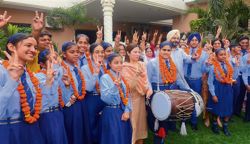
A visitor looks at photographs of the Partition at the Partition Museum in Amritsar. The historic Town Hall building houses the museum. Tribune Photo: Vishal Kumar.
Sukhpreet Kaur Dhindsa
ORAL histories; that have for the last seven decades punctuated the sighs of the Partition generation and memorabilia; that has soaked many a tear, will elucidate the largest mass migration in recorded human history in a first-of-its-kind Partition museum. The museum, housed in the newly renovated Town Hall building in Amritsar, will memorialise the stories of loss, turmoil and the indomitable spirit of the 14-million displaced population.
The Art and Cultural Heritage Trust has undertaken the herculean task of lending physical form to the reminiscences. It envisions the museum to be “a space of memory, healing and reconciliation” and also, “a space which memorialises the grit, courage and spirit of that generation”. The trust envisages it to be a centre of research and documentation, which will “raise the veil of silence surrounding Partition”. Kishwar Desai, Chairperson of the Art and Cultural Heritage Trust, feels that the Partition generation comprising octogenarians and nonagenarians is fading away and the museum will keep their “voices alive and tales intact”. She recounts that the day the museum office opened, the first visitor was a 87-year-old retired Subedar Major who had come in a bus all the way from Jalandhar to tell his family's story. He gave a moving and vivid account of his migration from Sialkot, and said that “at last someone wants to know what I and my family went through”.
Despite the pain, the alacrity with which the affected narrate their experiences augments the need and relevance of such a museum. They might recoil while narrating the barbarity, the horrors, the chaos, the uncertainty, the vulnerability; they were witness to but still want to be heard. As it is said, “That is the thing about pain. It demands to be felt.” The museum will possibly serve not only as a cathartic outlet but also as a follow-up space for reflection. The magnitude of the tragedy that unfolded during the 1947 Partition has very few parallels and, hopefully, it never has more.
The Rwandan genocide of 1994, which saw the brutal killing of over a million people over a span of 100 days, is one such unfortunate (though remote) parallel. It was seen by the world as a conflict between two tribes which was an explosion of the centuries-old animosity that the communities had harboured. But an exhibition commemorating 20 years of the genocide, which travelled across many countries, offered room for different perspectives. An installation by Brookie Maxwell displayed 13 hanging machetes (machete being the most commonly used weapon during the Rwandan genocide). On one side were engraved statements detailing the planned actions of genocide and on the other were quotes from those who carried out the genocide.
From one end it would seem that it was a meticulously planned genocide by vested interests, which included many countries, and from the other end, after reading the hateful statements, it would seem to one to be a spontaneous eruption. It leaves the visitor wondering whether it was planned to be “spontaneous” or was it actually spontaneous, and the other concurrent events coincidental?
Pluralistic first-hand narratives have the potential to untangle many knots and thereby such museums have the capacity to help communities learn from the past. The Partition museum will have even more lessons to offer; the stories of the invincible spirit that overcame the pain of seeing near and dear ones killed, the heartache of leaving homes and hometowns behind. Also, the financial turmoil and the physical hardships to emerge triumphant in the battle of life. These would demonstrate to today's depression-susceptible generation, a lesson it badly needs.
A museum does not have the capacity to address all underlying emotions and issues but even if it can address a few and give expression to unheard ordinary voices, it is more than worth it. The human, cultural, and economic price the Partition-affected states had to pay, is beyond valuation and any reparation. Nevertheless, acknowledging the unspeakable tragedy and designating a place to the same is doable and was long due.



























